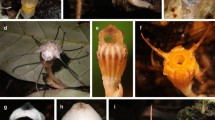Abstract
Tovomita (Clusiaceae, tribe Clusieae) comprises about 45 species with Neotropical distribution. Thirty of these species occur in the Brazilian Amazon and Atlantic forest, but have only been poorly sampled in studies of pollen morphology. Pollen grains of ten species of Tovomita and one of Tovomitopsis are characterized and illustrated here and morphologically compared with those from other extant genera of Clusiaceae s.s., as well as the fossil genus Paleoclusia (which shares with Tovomita prolate triaperturate pollen grains with reticulate exines and sexine elements inside the lumina). The pollen grains of the analyzed species of Tovomita were found to be tricolporate, with amb circular to subtriangular, and exine psilate to microreticulate. Tovomita pollen differs markedly from Tovomitopsis in terms of the tectum surface, which is smooth with regular baculate in the former, versus irregular and not smooth, with some twisted baculate processes, in the latter. Other pollen features among species of Clusiaceae are discussed in order to better characterize Tovomita and help elucidate generic limits among related genera.



Similar content being viewed by others
References
Barth OM (1963) Catálogo sistemático dos pólens das plantas arbóreas do Brasil meridional III—Theaceae, Marcgraviaceae, Ochnaceae, Guttiferae e Quiinaceae. Instituto Oswaldo Cruz, Rio de Janeiro, pp 97–104
Bittrich V, Amaral MCE, Machado SMF, Marsaioli AJ (2003) Floral resin of Tovomitopsis saldanhae (Guttiferae) and 7-epi-nemorosone: structural revision. Z Naturf C 58:643–648
Bittrich V, Trad RJ, Cabral F, Nascimento-Jr JE (2014) Clusiaceae In Lista de Espécies da Flora do Brasil. Jardim Botânico do Rio de Janeiro. http://floradobrasil.jbrj.gov.br/2012/FB006883. Accessed 19 Sept 2014
Crepet WL, Nixon KC (1998) Fossil Clusiaceae from the late Cretaceous (Turonian) of New Jersey and implications regarding the history of bee pollination. Amer J Bot 85:1122–1133
Cuello NL (2003) A new species of Tovomita (Clusiaceae) from Amazonian Venezuela and Peru. Novon 13:34–36
Erdtman G (1960) The acetolysis method. A revised description. Svensk Bot Tidskr 39:561–564
Gonçalves-Esteves V, Mendonça CBF (2001) Estudo polínico em plantas de restinga do Estado do Rio de Janeiro—Clusiaceae Lindl. Revista Brasil Bot 24:527–536
Gustafsson MHG, Bittrich V, Stevens PF (2002) Phylogeny of Clusiaceae based on rbcL sequences. Int J Pl Sci 163:1045–1054
Hammel BE (1999) Synopsis of Chrysochlamys (Clusiaceae: Clusioideae: Clusiae) in Mesoamerica. Novon 9:360–374
Maguire B (1977a) Notes on the Clusiaceae—chiefly of panama I. Phytologia 36:391–407
Maguire B (1977b) Notes on the Clusiaceae—chiefly of Panama II. Phytologia 38:203–214
Punt W, Hoen PP, Blackmore S, Nilsson S, Le Thomas A (2007) Glossary of pollen and spores terminology. Rev Palaeobot Palynol 143:1–81
Roubik DW, Moreno JEP (1991) Pollen and spores of Barro Colorado Island. Monogr Syst Bot Missouri Bot Gard 36:1–268
Ruhfel BR, Bittrich V, Bove CP, Gustafsson MHG, Philbrick CT, Rutishauser R, Xi Z, Davis CC (2011) Phylogeny of the clusioid clade (Malpighiales): evidence from the plastid and mitochondrial genomes. Amer J Bot 98:1–20
Ruhfel BR, Stevens PF, Davis CC (2013) Combined morphological and molecular phylogeny of the clusioid clade (Malpighiales) and the placement of the ancient rosid macrofossil Paleoclusia. Int J Pl Sci 174:910–936
Seetharam YN (1989) Diversity of androecium and pollen grains in the genus Garcinia L. and its bearing on geographical distribution and evolution. Proc Indian Acad Sci Pl Sci 99:107–115
Seetharam YN, Maheshwari JK (1986) Scanning electron microscopic studies on the pollen of some Clusiaceae. Proc Indian Acad Sci Pl Sci 96:217–226
Seetharam YN, Pocock SAJ (1978) Taxonomy and pollen morphology of Poeciloneuron (Guttiferae). Bull Jard Bot Nat Belg 48:359–365
Stevens PF (2014) Malpighiales in angiosperm phylogeny website. Version July 12, 2012 [and more or less continuously updated since]. http://www.mobot.org/MOBOT/research/APweb/ Accessed 19 Sept 2014
Thiers B (2014) Index herbariorum: a global directory of public herbaria and associated staff. New York botanical garden’s virtual herbarium. http://sweetgum.nybg.org/ih/. Accessed 19 Sept 2014
Vasconcellos NC, Carvalho MJC, Andrade TAP, Berg MEVD (1972) O pólen em plantas da Amazônia: Família Guttiferae. Bol Mus Paraense Emilio Goeldi 44:1–12
Vèsque J (1895) Guttiferae. In: De Candolle A, De Candolle C (eds) Monographiae Phanerogamarum, vol 8, p 676
Acknowledgments
We thank the Conselho Nacional de Desenvolvimento Científico e Tecnológico (CNPq) for awarding a Master’s Fellowship to LCM, and for the Research Productivity Fellowship to AMA (grant # 306992/2012–4) and FARS (grant # 303862/2013–0); laboratory work was financially supported by CNPq (Edital Reflora Malpighiales grant # 563548/2010-0, and Universal grant # 486079/2013–9). We thank the curators of CEPEC, HRB, and HUEFS for their permission to collect material from exsiccates, and the staff of the CEPEC Herbarium, the Centro de Miscroscopia Eletrônica (CME/UESC), and the Plant Micromorphology Laboratory (LAMIV/UEFS) for their assistance with the laboratory and fieldwork. We also thank the Dr. Roy Funch for their valuable criticism and suggestions for improving the English version of the manuscript.
Author information
Authors and Affiliations
Corresponding author
Additional information
Handling editor: Michael Hesse.
Rights and permissions
About this article
Cite this article
Marinho, L.C., Fiaschi, P., Amorim, A.M. et al. The taxonomic significance of pollen morphology in Tovomita Aubl. (Clusiaceae: Clusieae) and related genera. Plant Syst Evol 301, 1759–1766 (2015). https://doi.org/10.1007/s00606-014-1193-7
Received:
Accepted:
Published:
Issue Date:
DOI: https://doi.org/10.1007/s00606-014-1193-7




